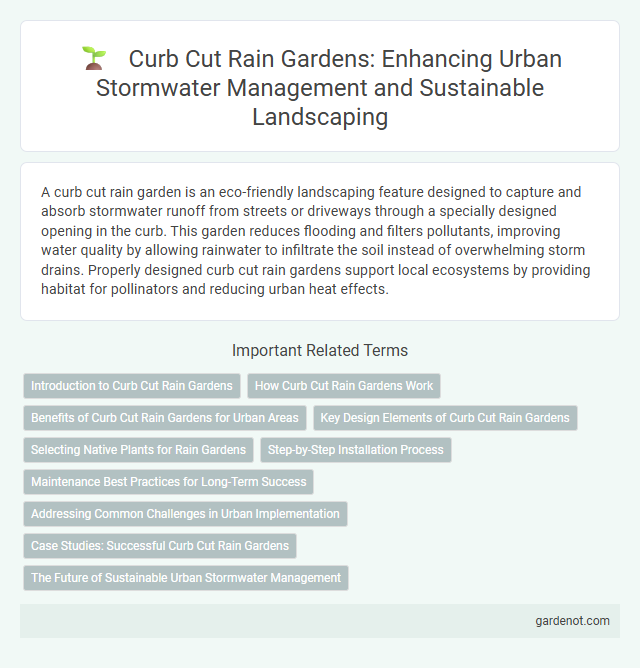A curb cut rain garden is an eco-friendly landscaping feature designed to capture and absorb stormwater runoff from streets or driveways through a specially designed opening in the curb. This garden reduces flooding and filters pollutants, improving water quality by allowing rainwater to infiltrate the soil instead of overwhelming storm drains. Properly designed curb cut rain gardens support local ecosystems by providing habitat for pollinators and reducing urban heat effects.
Introduction to Curb Cut Rain Gardens
Curb cut rain gardens are designed to capture and filter stormwater runoff from streets and sidewalks by directing water through a strategically placed opening in the curb. These gardens reduce urban flooding, improve water quality by trapping pollutants, and promote groundwater recharge in residential or commercial areas. Incorporating native plants in curb cut rain gardens enhances biodiversity while requiring minimal maintenance.
How Curb Cut Rain Gardens Work
Curb cut rain gardens function by directing stormwater runoff from streets into a vegetated basin through a carefully designed opening in the curb. This design slows water flow, allowing it to infiltrate the soil, filter pollutants, and reduce urban flooding. Native plants within the rain garden enhance water absorption while providing habitat and improving air quality.
Benefits of Curb Cut Rain Gardens for Urban Areas
Curb cut rain gardens effectively manage stormwater runoff in urban areas by capturing and filtering rainwater directly from streets, reducing pressure on municipal drainage systems. These gardens enhance groundwater recharge, mitigate flooding risks, and improve water quality by naturally removing pollutants. Integrating curb cut rain gardens contributes to urban biodiversity, creating green spaces that support pollinators and improve neighborhood aesthetics.
Key Design Elements of Curb Cut Rain Gardens
Curb cut rain gardens are designed to capture and filter stormwater runoff from streets through strategically placed curb openings that direct water into a planted basin. Key design elements include proper grading to ensure water flows smoothly into the garden, selection of native, water-tolerant plants that enhance infiltration and pollutant uptake, and a layered soil profile with a mix of sandy loam and organic matter to optimize drainage and filtration. Incorporating an overflow outlet prevents flooding during heavy rain events, ensuring functionality while protecting nearby infrastructure.
Selecting Native Plants for Rain Gardens
Selecting native plants for curb cut rain gardens enhances stormwater absorption and supports local biodiversity. Species such as switchgrass, blue flag iris, and swamp milkweed thrive in the wet, variable conditions typical of rain gardens, promoting soil stabilization and pollutant filtration. Incorporating deep-rooted native plants increases water infiltration rates while providing habitat for pollinators and wildlife.
Step-by-Step Installation Process
Installing a curb cut rain garden begins with selecting a suitable location along the curb where stormwater naturally collects, then marking and cutting a section of the curb to create an inlet for water flow. Excavation follows, shaping the basin to a depth of 6 to 12 inches with well-draining soil amended with compost to support healthy plant growth. Finally, native moisture-tolerant plants such as sedges, rushes, and wildflowers are planted to enhance water filtration and promote stormwater infiltration, reducing runoff and improving local water quality.
Maintenance Best Practices for Long-Term Success
Curb cut rain gardens require regular maintenance to ensure optimal performance, including periodic inspection of inlets and outlets to prevent clogging and erosion. Removing accumulated sediment and debris preserves infiltration capacity and helps maintain healthy plant growth. Seasonal pruning, weeding, and supplemental watering support vegetation establishment, which stabilizes soil and enhances pollutant filtration over time.
Addressing Common Challenges in Urban Implementation
Curb cut rain gardens effectively manage stormwater runoff by redirecting flow from paved surfaces into vegetated areas, reducing urban flooding and improving water quality. Key challenges include maintaining proper grading to prevent water pooling and ensuring soil infiltration rates align with local rainfall intensity to avoid overflow. Incorporating native plants with deep root systems enhances soil stabilization and pollutant filtration, promoting sustainable urban water management.
Case Studies: Successful Curb Cut Rain Gardens
Curb cut rain gardens effectively manage stormwater runoff by redirecting flow from impervious surfaces into vegetated areas, reducing urban flooding and improving water quality. Case studies in Portland, Oregon, and Seattle, Washington, demonstrate significant decreases in combined sewer overflow events and enhanced urban biodiversity through strategically placed curb cut rain gardens. These projects highlight the benefits of integrating permeable landscaping with municipal stormwater infrastructure for sustainable urban water management.
The Future of Sustainable Urban Stormwater Management
Curb cut rain gardens represent a transformative approach in sustainable urban stormwater management by enhancing groundwater recharge and reducing surface runoff in densely built environments. Integrating permeable curb cuts with native plant species effectively filters pollutants, decreases urban heat islands, and mitigates flooding risks associated with climate change. Advances in green infrastructure technologies and smart sensors will further optimize these rain gardens' performance, enabling cities to meet stringent stormwater regulations and build resilient, adaptive urban ecosystems.
Curb cut rain garden Infographic

 gardenot.com
gardenot.com